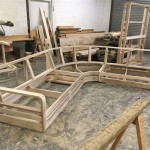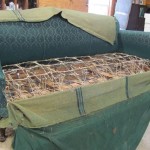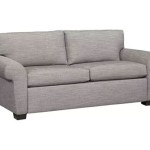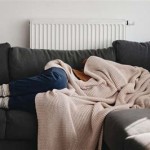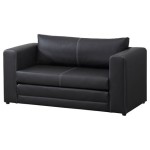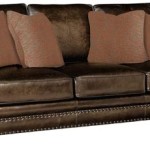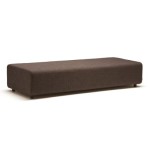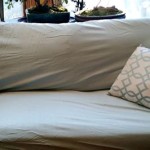Sofa Cushion Seat Pads: Enhancing Comfort and Extending Furniture Lifespan
Sofa cushion seat pads are integral components of upholstered furniture, playing a crucial role in determining the overall comfort, support, and longevity of sofas and chairs. The quality and characteristics of these pads significantly impact the user experience, influencing posture, pressure distribution, and the perceived value of the furniture itself. This article will explore the various aspects of sofa cushion seat pads, including their materials, construction methods, considerations for selection, and benefits for both the user and the furniture.
A sofa cushion seat pad, at its core, is a shaped piece of material designed to provide cushioning and support within the seat of a sofa. These pads are typically enclosed within fabric covers, matching or complementing the overall upholstery of the furniture. Their primary function is to distribute weight evenly, preventing pressure points and promoting comfortable seating for extended periods. Beyond mere comfort, well-designed seat pads contribute to proper posture, reducing the likelihood of back pain and discomfort associated with prolonged sitting.
The performance of a sofa cushion seat pad is determined by several key factors, including the type of material used, the density and firmness of the padding, and the construction techniques employed during manufacturing. Selecting the appropriate seat pads is essential for achieving the desired level of comfort, support, and durability. Ignoring these factors can lead to premature wear and tear, discomfort for the user, and ultimately, a diminished lifespan for the sofa itself.
Materials Used in Sofa Cushion Seat Pads
The materials used in the construction of sofa cushion seat pads are diverse, each offering distinct advantages and disadvantages in terms of comfort, durability, and cost. Understanding these material properties is crucial for making informed decisions when selecting or replacing seat pads. Common materials include various types of foam, fiberfill, and combinations thereof.
Polyurethane Foam: Polyurethane foam is a widely used material in sofa cushion seat pads due to its versatility and cost-effectiveness. It is available in a range of densities and firmness levels, allowing manufacturers to tailor the cushioning to specific needs. High-density polyurethane foam offers excellent support and durability, making it suitable for high-traffic areas. Lower-density foams, while more affordable, may compress more quickly and offer less long-term support. The open-cell structure of polyurethane foam allows for airflow, contributing to breathability and reducing heat buildup.
Memory Foam: Memory foam, also known as viscoelastic foam, is a type of polyurethane foam that conforms to the shape of the body, providing customized support and pressure relief. It responds to heat and weight, molding itself to the contours of the user. This characteristic makes memory foam particularly effective at alleviating pressure points and promoting even weight distribution. While memory foam offers exceptional comfort, it can retain heat, which may be a concern for some users, especially in warmer climates. Newer formulations of memory foam incorporate cooling gels or open-cell structures to mitigate this issue.
Latex Foam: Latex foam is a natural or synthetic rubber-based material that offers a balance of comfort, support, and durability. Natural latex foam is derived from the sap of rubber trees and is known for its resilience and hypoallergenic properties. Synthetic latex foam, typically made from styrene-butadiene rubber (SBR), offers similar characteristics at a lower cost. Latex foam is naturally breathable and resistant to mold and mildew, making it a suitable choice for individuals with allergies or sensitivities. Its inherent elasticity allows it to retain its shape and provide consistent support over time.
Fiberfill: Fiberfill consists of loose fibers, typically polyester or a blend of synthetic materials, that are used to create a soft and plush cushioning. Fiberfill is often used in combination with foam cores to provide a comfortable surface feel. It is lightweight, affordable, and easy to maintain. However, fiberfill tends to compress over time, requiring periodic fluffing to maintain its loft and shape. The durability of fiberfill cushions depends on the quality of the fibers and the density of the fill.
Down and Feather: Down and feather fill is a traditional option for sofa cushion seat pads, offering a luxurious and exceptionally soft feel. Down consists of the soft, fluffy plumage found beneath the outer feathers of birds, while feathers provide more support and structure. Down and feather cushions are highly compressible and offer excellent insulation. However, they require regular fluffing to maintain their shape and loft. Down and feather fill can also trigger allergies in some individuals. Due to rising costs and ethical concerns, down and feather fill is becoming less common in mass-produced furniture.
Blend Materials: Many sofa cushion seat pads utilize a combination of different materials to achieve a specific balance of comfort, support, and cost. For example, a cushion may consist of a high-density polyurethane foam core wrapped in a layer of fiberfill for added softness. Another common combination is a memory foam top layer over a supportive polyurethane foam base. These blended approaches allow manufacturers to optimize the performance of the seat pads while controlling costs.
Construction Methods and Design Considerations
The construction methods employed in the manufacturing of sofa cushion seat pads play a crucial role in their overall durability, shape retention, and comfort. Different construction techniques can influence the way the cushion distributes weight, the resilience of the padding, and the aesthetic appearance of the finished product.
Box Cushions: Box cushions are the most common type of sofa cushion seat pad. They are constructed with a rectangular or square shape and have seams on all four sides. This design provides a structured and tailored appearance. Box cushions are typically filled with foam, fiberfill, or a combination of materials. The firmness and density of the filling can be adjusted to achieve the desired level of support and comfort. The edges of box cushions are often reinforced with welting or piping to enhance their durability and prevent fraying.
Knife-Edge Cushions: Knife-edge cushions have a simpler design than box cushions, with a seam only around the perimeter. They lack the structured edges of box cushions, resulting in a softer and more relaxed appearance. Knife-edge cushions are typically filled with fiberfill or down and feather, providing a plush and informal seating experience. They are often used in casual or bohemian-style furniture. However, knife-edge cushions may not offer as much support as box cushions, and they may require more frequent fluffing to maintain their shape.
T-Cushions: T-cushions are designed to fit around the arms of a sofa, creating a seamless and integrated look. They are typically used in sofas with rolled or flared arms. T-cushions can be constructed with either a box-edge or a knife-edge design. The shape of the T-cushion requires precise cutting and sewing to ensure a proper fit. They offer a comfortable and supportive seating experience and are often found in traditional and transitional furniture styles.
Button-Tufted Cushions: Button-tufted cushions are characterized by evenly spaced buttons that are sewn through the cushion, creating a decorative and textured surface. This construction method adds visual interest and helps to secure the filling in place. Button-tufted cushions can be filled with foam, fiberfill, or down and feather. They are often used in formal or traditional furniture styles. The buttons can create pressure points for some users, so careful consideration should be given to their placement and size.
Channel-Back Cushions: Channel-back cushions feature vertical channels or rows of stitching that run along the length of the cushion. These channels help to prevent the filling from shifting and clumping, ensuring even distribution of support. Channel-back cushions are typically filled with fiberfill or down and feather. They are often used in sofas and chairs with high backs or contoured designs. The channels provide a subtle visual texture and enhance the overall comfort of the cushion.
Considerations for Selecting Sofa Cushion Seat Pads
When selecting sofa cushion seat pads, it is important to consider several factors, including the intended use of the furniture, the desired level of comfort and support, the aesthetic preferences of the user, and the budget. A careful assessment of these factors will help to ensure that the chosen seat pads meet the specific needs and requirements of the individual and the furniture.
Comfort and Support: The primary function of sofa cushion seat pads is to provide comfort and support. The ideal level of comfort and support will vary depending on the individual's preferences and needs. Individuals who prefer a firm and supportive seat should opt for high-density foam or latex foam cushions. Those who prefer a softer and more plush seat may prefer fiberfill or down and feather cushions. It is important to test the cushions before purchasing them to ensure that they provide the desired level of comfort and support.
Durability: The durability of sofa cushion seat pads is another important consideration, especially for furniture that will be used frequently. High-density foam and latex foam cushions are generally more durable than fiberfill or down and feather cushions. The construction method and the quality of the fabric cover also contribute to the overall durability of the cushions. Investing in high-quality cushions will ensure that they last longer and maintain their shape and support over time.
Maintenance: The maintenance requirements of sofa cushion seat pads should also be considered. Some materials, such as fiberfill and down and feather, require regular fluffing to maintain their shape and loft. Foam cushions may require occasional cleaning to remove stains and spills. The fabric cover should be durable and easy to clean. Choosing cushions with removable and washable covers can simplify the maintenance process. Regular cleaning and maintenance will help to extend the lifespan of the cushions and keep them looking their best.
Aesthetics: The aesthetic appearance of sofa cushion seat pads should complement the overall style of the furniture and the room. The fabric cover should match or coordinate with the upholstery of the sofa or chair. The shape and design of the cushions should enhance the visual appeal of the furniture. Considering the aesthetics of the cushions will help to create a cohesive and stylish look.
Budget: The budget is always a factor when selecting sofa cushion seat pads. The cost of cushions can vary widely depending on the materials used, the construction method, and the brand. It is important to set a budget and stick to it. However, it is also important to consider the long-term value of the cushions. Investing in high-quality cushions may cost more upfront, but they will last longer and provide better comfort and support over time, ultimately saving money in the long run.

Cotton Chunky Booster Cushion Thick Seat Pads Chair Armchair Sofa Mat

Spring Park Square Seat Pad Chair Cushion Dining Room Kitchen Decor Sofa Pillow Tie On Com

Thick Bench Seat Cushion Chair Pad Sofa Cushions Home Decor

16x16 Inch 10 Colors Soft Non Slip Dining Kitchen Square Chair Cushion Seat Pads Removable Cover On Garden Com

Chair Pads Cloth Cotton Linen Cushion Party Dining Seat Tie Sofa Pillow Furniture Garden Outdoor Thick Soft Indoor Cushions Pillows With Ties

Square Office Chair Cushions Soft Fuzzy Warm Seat Cushion Pads For Home Dining Chairs Sofa Car Wheelchair China And Made In Com

22 Thicken Corduroy Chair Cushion Round Seat

Cooling Ice Silk Sofa Cushion For Summer Non Slip Luxurious And Refre

Buy Whole China Outdoor And Indoor Sofa Patio Seat Deep Chair Cushion Furniture Pads Global Sources

Heavy Duty Couch Sofa Cushion Support For Sagging Seat Cushions Boards Black

